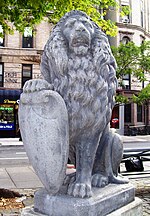1975 New York Telephone exchange fire
The New York Telephone exchange fire occurred on February 27, 1975, at the New York Telephone Company switching center at 204 Second Avenue and Thirteenth Street in the East Village of Manhattan, New York City. At this time, the building contained central offices for connecting local customer telephone lines, as well as toll switching systems. The fire disrupted service for 175,000 customers, connected within the building through 105,000 service loops. It was the worst single service disaster suffered by any single Bell operating company in the 20th century. The events relating to the fire make it notable for several reasons, including the extent of the disruption, the large scale and speed of the recovery efforts, which were completed in 23 days, and the succeeding influence on adoption of fire safety rules for installation of low-voltage wiring inside buildings, especially in areas that can spread fire or toxic fumes. Decades later the polyvinyl chloride (PVC) combustion products produced by the fire were identified as a reason for elevated rates of cancer in the firefighters at the scene.
Excerpt from the Wikipedia article 1975 New York Telephone exchange fire (License: CC BY-SA 3.0, Authors).1975 New York Telephone exchange fire
2nd Avenue, New York Manhattan
Geographical coordinates (GPS) Address Nearby Places Show on map
Geographical coordinates (GPS)
| Latitude | Longitude |
|---|---|
| N 40.7314 ° | E -73.9852 ° |
Address
2nd Avenue 204
10035 New York, Manhattan
New York, United States
Open on Google Maps





